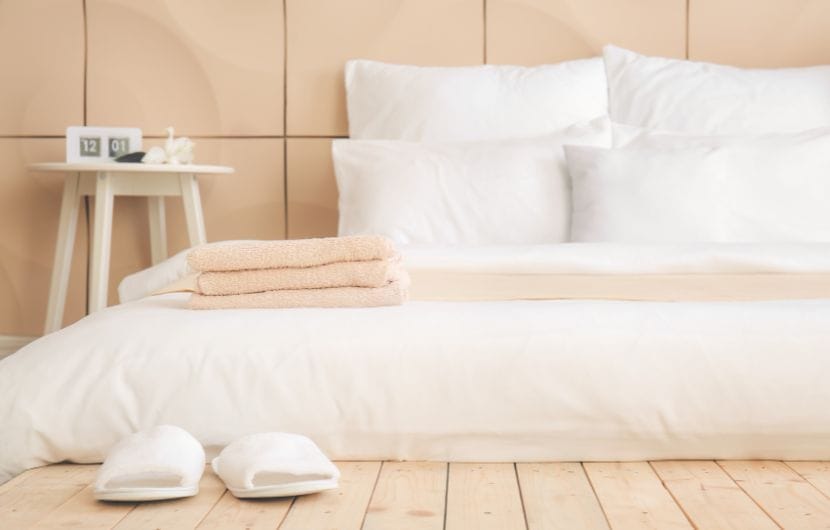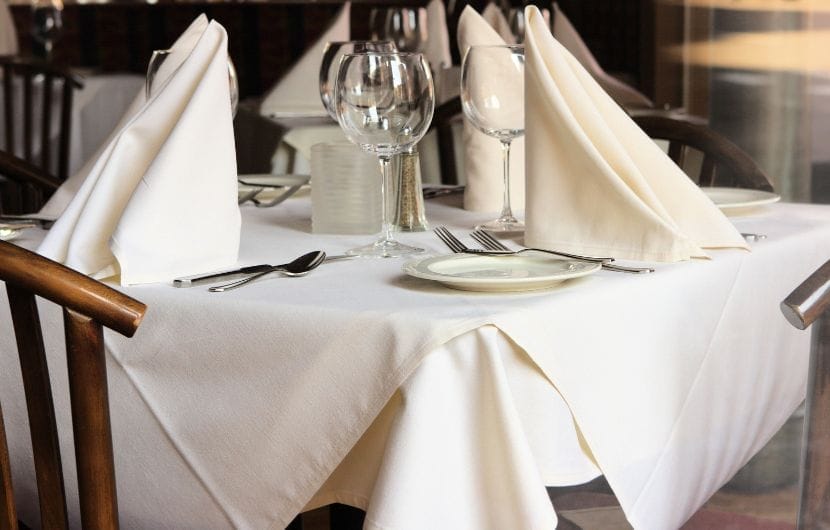Blog
What Is Hotel Linen?
Introduction
Quality hotel linen is the foundation of guest satisfaction and operational success. Whether you’re a hospitality buyer or vacation rental host, understanding hotel textiles—from materials to lifecycle management—drives smarter decisions and better experiences. 
What Is Linen in the Hotel?
In the textile world, the term “linen” originally referred to fabric made from flax. However, in the hospitality industry, “hotel linen” is a broader term that includes all textile products used in a hotel—from bed sheets to towels to tablecloths—regardless of the actual material.
Hotel vs. Home Linen
While home linens are selected for personal comfort, hotel linens are chosen for high performance, durability, and repeated laundering. Hotel linens must balance softness with strength to meet commercial-grade demands.
What Is a Linen Room in Hotel Housekeeping?
A hotel’s linen room is the centralized storage space for clean and soiled linen. It acts as a logistics hub where linen is sorted, distributed, and managed—ensuring each room is properly stocked for housekeeping.
Why Do Hotels Use White Linen?
White linen is synonymous with cleanliness, luxury, and transparency. It gives a fresh appearance, is easy to bleach and sanitize, and allows staff to easily detect stains or wear, maintaining hygiene standards.
Why Hotel Linen Quality Matters
- Brand Image: Clean, crisp linens not only create a strong first impression that reflects the hotel’s standards but also serve as a powerful point of brand differentiation.
- Guest Comfort: Soft sheets and fluffy towels make guests feel pampered and well cared for.
- Durability & Operational Efficiency: Quality linens withstand industrial laundering and reduce replacement frequency.
Recommended reading: Feather vs. Down-Alternative Pillows
Types of Hotel Linen
| Category | Items |
| Bedding Linen | Flat Sheets, Fitted Sheets, Pillowcases, Duvet Covers, Mattress Protectors |
| Bathroom Linen | Bath Towels, Hand Towels, Face Towels, Bathrobes, Bath Mats |
| Restaurant & Banquet Linen | Tablecloths, Napkins, Chair Covers |
| Spa or Pool Linen (if applicable) | Spa Towels, Pool Towels, Wraps and Robes |

Materials Used in Hotel Linen
- Cotton: Preferred for softness and breathability. Egyptian and Pima cotton are premium options known for durability and luxury.
- Cotton-Poly Blends: Popular for their balance between softness and strength, these blends dry faster and resist wrinkling.
- Bamboo or Microfiber: Found in upscale properties; these materials offer hypoallergenic and eco-friendly properties.
- Linen Fabric (Flax): Used in boutique hotels for a natural, textured look, though less common due to maintenance complexity.
Choosing the right material depends on your hotel’s standards and budget. Other considerations include:
- GSM and Thread Count: GSM (grams per square meter) measures towel thickness, while thread count refers to bed linen quality—key indicators for B2B buyers.
- Hotel Linen Trends: Demand is growing for sustainable fabrics, allergen-free textiles, and custom-branded linens that reinforce hotel identity.
Hotel Linen Sizes and Standards
- International/Regional Differences: Sheet and towel sizes can vary by country; be sure to match local standards.
- Fitted vs. Flat Sheets: Hotels often prefer flat sheets for ease of handling and universal fit.
- Towel Dimensions: Common hotel sizes include:
- Bath towel: 27″ x 54″
- Hand towel: 16″ x 30″
- Washcloth: 13″ x 13″
More tips: 10 Hotel Amenities That Make Stays Unforgettable

Lifecycle of Hotel Linen
By mapping out each stage—from fiber choice to final retirement—hotels can improve service quality, control expenses, and bolster their sustainability credentials.
1. Sourcing & Procurement
- Fabric selection: Choose fiber type (cotton, blend, bamboo, etc.) based on durability, feel, cost, and sustainability credentials (OEKO‑TEX, GOTS).
- Supplier evaluation: Procurement isn’t just picking a product—it’s building partnerships. Please assess lead times, minimum order quantities, customization (logo, size, color accents, embroidery) to elevate branding and guest recognition, samples test before bulk orders, and after‑sales support.
- Initial investment: Balance upfront cost vs. expected lifespan (GSM, thread count, construction quality) to optimize total cost of ownership.
2. Receiving & Inspection
- Quality check on delivery: Verify dimensions, color consistency, stitching quality, and fabric hand‑feel.
- Inventory tagging: Use barcodes or RFID tags to track individual items through their service life.
- Quarantine for first wash: Some hotels pre‑wash new linens to remove finishes and improve absorbency.
3. In‑Service Use
- Guest deployment: Linens are placed in guestrooms, spas, restaurants, or back‑of‑house (staff uniforms, cleaning cloths).
- Rotation schedule: High‑traffic items (towels, sheets) follow daily or per‑stay rotation; lower‑usage items on multi‑day cycles.
4. Collection & Soiled Sorting
- Consolidation points: Housekeeping carts and spa/laundry chutes collect used items by department.
- Pre‑sorting: Separate by soil level, fabric type, and color to optimize wash cycles and prevent damage.
5. Commercial Laundering
- Wash parameters: High‑temperature sanitizing, chemical dosage, and mechanical action tailored per fabric to remove stains while preserving integrity.
- Drying & finishing: Tumble or flat‑drying followed by pressing or folding; some properties use automated folder machines for efficiency.
6. Inspection & Repair
- Quality control: Post‑wash inspection for holes, loose threads, fading, or weakened hems.
- Minor repairs: Re‑stitching hems, patching small tears extends usable life.
- Rejects: Severely damaged items removed from active inventory.
7. Re‑stocking & Redistribution
- Inventory replenishment: Clean, repaired linens return to the linen room and are allocated back into service based on department demands.
- Data‑driven forecasting: Usage logs and RFID tracking help predict reorder points and minimize stockouts.
8. End‑of‑Life & Disposal
- Lifecycle threshold: Typically 300–500 commercial wash cycles, depending on fabric and care.
- Sustainable disposal
- Donate usable linens to shelters or veterinary clinics.
- Recycle fibers into cleaning rags, insulation batting, or upcycle into décor.
- Replacement planning: Phased procurement ensures a smooth transition without service gaps.
Why Understanding the Lifecycle Matters
- Cost optimization: Knowing when to repair vs. replace maximizes ROI.
- Operational efficiency: Streamlined processes reduce labor, energy, and chemical costs.
- Brand consistency: Well‑managed linen programs maintain a uniform guest experience.
- Sustainability: Extending linen life and recycling reduces waste and aligns with green initiatives.
QL Textiles delivers 20+ years of proven hospitality textile expertise with 99.9% on-time delivery, ISO9001/OEKO-TEX certifications, and comprehensive manufacturing capacity. Their bulk pricing, and pro custom solutions make them ideal for hotels and B2B wholesalers seeking reliable, quality partners.

Conclusion
Hotel linen may seem like a simple detail, but it plays a powerful role in hospitality success. From luxury guest experiences to back-end efficiency and brand perception, quality linens are an investment—not just a purchase. Whether you’re a hotel buyer looking for bulk procurement or a homeowner seeking premium comfort, understanding hotel linen is the first step toward better sleep, better service, and better value.
Conclusion
Introduction Quality hotel linen is the foundation of guest satisfaction and operational success. Whether you’re a hospitality buyer or vacation
Leave a Comment

 Nov 27, 2025
Nov 27, 2025 
